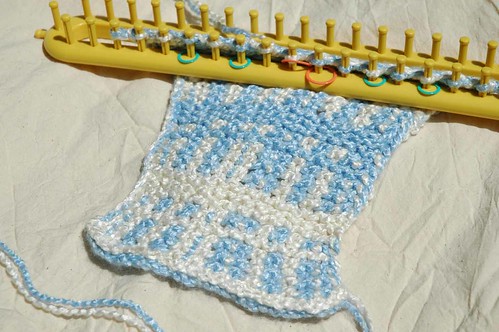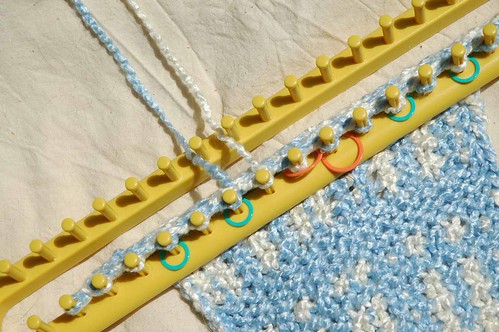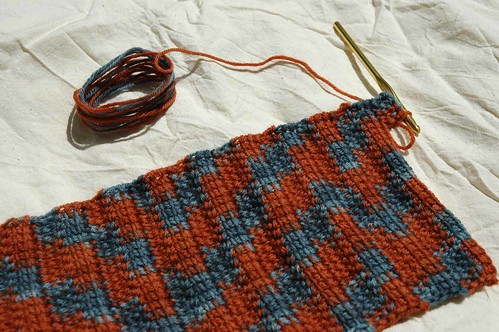
As any regular readers know, I've been working on two scarves for two friends - a couple - moving to Chicago from here in balmy Charleston. What you see above is the Girl-Chicago scarf in progress. (There's nothing necessarily girly about the pattern, but the yarn and colors make it more feminine. I'm thinking I may make a version in Vikings, Twins, or SUNY Buffalo colors for my husband - but that's a long way off). The recipient isn't a terribly girly-girl, and I wanted something easy to knit but complex enough to be worth making a pattern. I'd been considering designing a plaid for a while, and this slick, bulky yarn doesn't lend itself to a very wide panel, so the above design was invented.
 I started by casting on first the white and then the blue - separately - using a crochet chain. I made a chain the length of the number of pegs (16) times two (32) minus one (31). I then slipped the first chain over the first peg, skipped a chain, slipped the next one over the next peg, on down the line. If the last peg is tricky for you, or your chain keeps coming unraveled, then just chain extra, and when you get to the last peg, put your finger or hook in the chain that will be going on that last peg, unravel back to that point, then place the loop on the peg such that the yarn is wrapping around it clockwise. (This assumes you cast on right-to-left like me and that you slip the last peg every time, also like me. As long as the yarn comes around the back of the last peg and crosses to the front of the next peg, you're fine.) The effect, as you can see, is a two-layer look. I really like it, but it will require casting off each color separately if you want your two ends to match. I'll have to save that for next week!
I started by casting on first the white and then the blue - separately - using a crochet chain. I made a chain the length of the number of pegs (16) times two (32) minus one (31). I then slipped the first chain over the first peg, skipped a chain, slipped the next one over the next peg, on down the line. If the last peg is tricky for you, or your chain keeps coming unraveled, then just chain extra, and when you get to the last peg, put your finger or hook in the chain that will be going on that last peg, unravel back to that point, then place the loop on the peg such that the yarn is wrapping around it clockwise. (This assumes you cast on right-to-left like me and that you slip the last peg every time, also like me. As long as the yarn comes around the back of the last peg and crosses to the front of the next peg, you're fine.) The effect, as you can see, is a two-layer look. I really like it, but it will require casting off each color separately if you want your two ends to match. I'll have to save that for next week! The slip stitches on the ends are both colors held together. I carry both colors across the row simultaneously; the key to getting the varied stripes is twisting the strands between every stitch. What you can see in this picture on the left is that I have knit a blue stitch (on the peg with the green marker) and then a white stitch to its right. I will then cross the blue over the white. If the next stitch was to be blue, that's all I would do - cross blue over white, and knit blue. But because the next stitch will be white (two white stripes in a row) I cross the blue over white, then white over blue as well. Making this twist prevents the loop that would be formed by the blue running along the back without the white to hold it in. This would be fine on a hat or other garment if it didn't go more than three stitches, but I twist in the blue here for two reasons. One, it makes the other side of the scarf more consistent (see below). Two, it creates a dotted stripe of one color (here blue) peeking through the other (here white).
The slip stitches on the ends are both colors held together. I carry both colors across the row simultaneously; the key to getting the varied stripes is twisting the strands between every stitch. What you can see in this picture on the left is that I have knit a blue stitch (on the peg with the green marker) and then a white stitch to its right. I will then cross the blue over the white. If the next stitch was to be blue, that's all I would do - cross blue over white, and knit blue. But because the next stitch will be white (two white stripes in a row) I cross the blue over white, then white over blue as well. Making this twist prevents the loop that would be formed by the blue running along the back without the white to hold it in. This would be fine on a hat or other garment if it didn't go more than three stitches, but I twist in the blue here for two reasons. One, it makes the other side of the scarf more consistent (see below). Two, it creates a dotted stripe of one color (here blue) peeking through the other (here white).(Needle knitters, please ignore this part.) The scarf is done in garter stitch - all knit left to right, all purl right to left. On the purl pass, I twist the yarns in the opposite direction - right over left - to avoid twisting the skeins up and because it's easier for me.
 So, how does the reverse look? Like static, actually, with stripes of solid color. I could have avoided the latter by keeping the alternate color running along with the main color, but I wanted to vary the texture of the scarf. Those solid rows are not knit with both colors. The plaid itself if indiscernible from the reverse, which was my intent. To me, it looks a bit like a blizzard of color - we used to call TV static snow for a reason after all. And that's Chicago.
So, how does the reverse look? Like static, actually, with stripes of solid color. I could have avoided the latter by keeping the alternate color running along with the main color, but I wanted to vary the texture of the scarf. Those solid rows are not knit with both colors. The plaid itself if indiscernible from the reverse, which was my intent. To me, it looks a bit like a blizzard of color - we used to call TV static snow for a reason after all. And that's Chicago.The other scarf, just to give you a little preview, is done in linked treble crochet and looks like this:

I'll talk more about the rest of both scarves in future posts. In the meantime, enjoy the rest of the weekend!

No comments:
Post a Comment